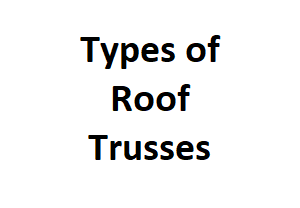When it comes to constructing a durable and aesthetically appealing roof, trusses play a crucial role. Roof trusses are engineered frameworks that support the roof and distribute its weight to the walls. These structures come in various designs, each tailored to specific architectural requirements and load-bearing capacities. There are different types of roof trusses. In this blog post, we will explore the most common types of roof trusses and their unique characteristics.
1. King Post Truss
The King Post truss is one of the simplest and oldest truss designs. It consists of three main components: a horizontal tie beam, two sloping rafters, and a central vertical post (king post). This type of truss is commonly used for small to medium-span roofs, such as in garages, porches, and small cabins. Its simplicity makes it a cost-effective option for basic roof structures.
Advantages:
- Easy to construct and install.
- Cost-effective for small projects.
- Ideal for short spans and low-pitched roofs.
Disadvantages:
- Limited load-bearing capacity.
- Not suitable for wide spans or complex architectural designs.
2. Queen Post Truss
The Queen Post truss is an extension of the King Post truss, providing additional support and stability. Instead of a single central post, it features two vertical posts known as queen posts. These queen posts help to distribute the load more evenly and allow for longer spans compared to the King Post truss.
Advantages:
- Improved load-bearing capacity over King Post truss.
- Suited for medium-sized residential roofs and agricultural buildings.
- Provides a more open and spacious interior compared to other truss types.
Disadvantages:
- More complex to fabricate and install than King Post truss.
- May require extra bracing to ensure structural integrity.
3. Howe Truss
The Howe truss is a popular choice for medium to long-span roofs, particularly in industrial and commercial buildings. It features a combination of vertical and diagonal members that form a series of triangles, providing excellent stability and load-bearing capabilities. This type of truss is commonly used in factories, warehouses, and gymnasiums.
Advantages:
- High load-bearing capacity.
- Well-suited for long spans and heavy roof loads.
- Offers versatility in design and can accommodate different architectural styles.
Disadvantages:
- More complex to design and manufacture than simpler truss types.
- May require larger members, leading to increased material costs.
4. Scissor Truss
The Scissor truss is an aesthetically appealing option that creates a vaulted or cathedral-like ceiling. It consists of two sloping members crossing each other and connected at the midpoint, resembling the shape of an open pair of scissors. This truss type is often used in residential buildings where an open and spacious interior is desired.
Advantages:
- Allows for a vaulted ceiling with increased vertical space.
- Conceals horizontal tension members, providing a clean and attractive appearance.
- Suitable for rooms requiring extra height, such as living rooms or great rooms.
Disadvantages:
- Reduced attic space for storage due to the angled design.
- Requires more labor for installation compared to traditional trusses.
5. Gambrel Truss
The Gambrel truss is commonly found in barns and Dutch colonial-style homes. It features a symmetrical two-sided roof with two slopes on each side, offering additional space and headroom in the attic area. The lower slope is steeper, while the upper slope is more gradual.
Advantages:
- Maximizes usable space in the attic.
- Resembles traditional architectural styles, adding character to the building.
- Suitable for buildings with steeply pitched roofs.
Disadvantages:
- Not as structurally efficient as other truss types for longer spans.
- Limited use in modern architectural designs.
6. Pratt Truss
The Pratt truss is a common and efficient truss design used for medium to long spans. It consists of diagonal members slanting towards the center of the truss and vertical members that support the load. The Pratt truss is widely used in bridges, railway structures, and industrial buildings.
Advantages:
- Excellent load-carrying capacity.
- Well-suited for long-span applications.
- Efficient use of materials, reducing overall costs.
Disadvantages:
- Diagonal members are subject to compression and may require additional bracing.
- Not as visually appealing as some other truss types.
7. Warren Truss
The Warren truss is another popular choice for long-span roofs and bridges. It features diagonal members that alternate in direction and meet at the truss’s center. This design evenly distributes the load and provides a robust and lightweight structure.
Advantages:
- Efficient use of materials, leading to cost savings.
- Suitable for spans where a large open space is needed.
- Relatively simple to manufacture and install.
Disadvantages:
- May require extra support for longer spans to avoid excessive deflection.
- Limited architectural variation due to its repetitive design.
8. North Light Truss
The North Light truss is commonly used in industrial and commercial buildings, especially those requiring large expanses of open floor space, such as factories and warehouses. It features a series of inclined rafters with a horizontal bottom chord and vertical top chord, providing excellent strength and support.
Advantages:
- Offers large unobstructed floor areas, ideal for industrial purposes.
- Allows natural light to enter the building through the clearstory windows.
- Can be cost-effective for wide-span structures.
Disadvantages:
- Requires additional considerations for insulation and climate control due to the clearstory design.
- Limited aesthetic appeal for residential or architectural buildings
9. Fink Truss
The Fink truss is a highly efficient and commonly used design for residential and commercial roofs. It consists of a combination of diagonal and vertical members, forming a series of triangles. This truss type is known for its strength-to-weight ratio and adaptability to various spans.
Advantages:
- Lightweight yet sturdy construction.
- Suitable for a wide range of spans and roof pitches.
- Allows for easy installation of insulation and utilities within the truss.
Disadvantages:
- The need for additional bracing to resist lateral forces.
- Limited design variations compared to more complex truss types.
Conclusion
The choice of roof trusses types depends on various factors, including span length, load requirements, architectural design, and budget constraints. Each truss design offers unique advantages and disadvantages, making it essential for architects, engineers, and builders to carefully consider the specific needs of each project.
By understanding the characteristics of different types of roof trusses, construction professionals can make informed decisions that result in safe, durable, and visually appealing roof structures. Ultimately, the proper selection and implementation of roof trusses contribute significantly to the overall stability and longevity of a building, ensuring a secure and comfortable space for its occupants.

